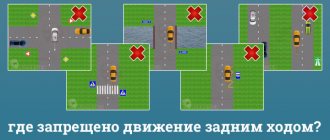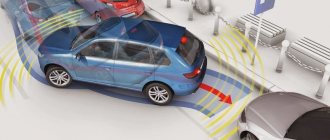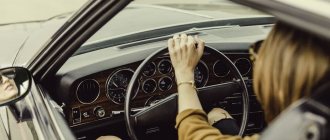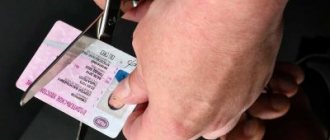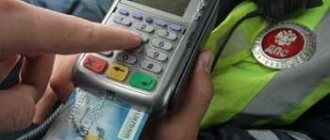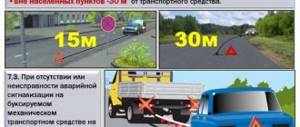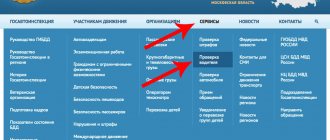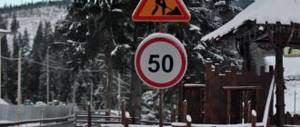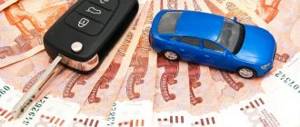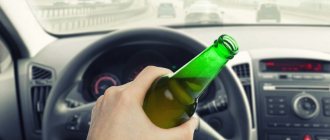What to do first in such an accident?
As with any other accident, the driver should first of all comply with the requirements of the Road Traffic Rules, namely paragraphs 2.5-2.6.1.
Including:
- stop reversing and stop (do not move the vehicle),
- turn on the emergency lights and put up a sign,
- do not move car fragments or any other objects,
- If a car is obstructing the passage, then clear the passage, having first recorded everything in a photo/video.
Don't forget about witnesses to the accident. It’s better to look for them right away on the spot before they go about their business.
And, of course, it is necessary to register the accident itself, if the damage was caused only to vehicles, there were no more than two of them, the drivers are insured for liability under compulsory motor liability insurance, everything is clear to everyone and they agree with all the circumstances - then the European protocol. But we must take into account the limits of the European protocol. If the damage is large, then it is better to register it through the traffic police officers.
When can you go back?
When and where is it allowed to drive in reverse on vehicles:
- such maneuvers are permissible on areas (or roads) with established one-way traffic,
- in a parking lot (parking lot) where there are no signs (signs) that prohibit (limit) such maneuvers.
There are not many places where reversing is allowed by the Rules, but there are many restrictions.
Maneuvering is possible in places where it is permitted and subject to certain conditions:
- the driver has made sure that the maneuver he is performing is safe for him, surrounding people and vehicles,
- the driver has checked the space where the movement will be carried out and made sure that there are no obstacles, as well as the availability of space for maneuvering, taking into account further turning,
- the maneuver is carried out at low speed.
What to do if the culprit of an accident does not have insurance?
There is no need to maneuver, moving backwards, if the view on the road is limited and visibility is poor. In this case, the driver should use the help of third parties (passers-by, passengers).
Only by observing these conditions, the driver is allowed to drive the vehicle in reverse. When an emergency situation is created, the fact of failure to comply with these requirements will indicate the driver’s guilty actions and may be regarded as an aggravating circumstance. When drawing up documents, the inspector will indicate this, and the court will take it into account when making a decision.
Watch the video. Driving lesson on driving in reverse:
What are the consequences of an accident when driving backwards?
As a rule, responsibility for the violation itself is much less than the damage caused, and the driver who is guilty of an accident may simply “not notice” the fine, if there is one. But who is usually at fault and will there be even the smallest fine or not?
Who is usually to blame?
Paragraph 8.12 of the traffic rules is written in such a way that the one who was moving in reverse, as a rule, is to blame for the traffic accident. After all, driving backwards is allowed only if it is safe and does not interfere with others.
In most cases, traffic police inspectors charge a violation of 8.12 to the person who performed this maneuver. But in the judicial practice of 2021 there are enough such cases that have been successfully challenged.
What's the fine?
To get a fine for driving a car backwards, you need to try harder, so to speak.
- The fact is that in the general case there is no fine or punishment for such a maneuver - there is simply no sanction for this violation in the current Code of Administrative Offenses of the Russian Federation, and the driver does not face anything.
- But in order for the driver to be issued a decree, he must drive in reverse in a place where such a maneuver is prohibited. In this case, he faces liability under Part 2 of Article 12.14 of the Code of Administrative Offenses of the Russian Federation in the form of a fine of 500 rubles.
- No, well, you can, of course, violate 2,500 rubles, but to do this you need to drive in reverse on the highway. Then they will be charged under another article of the Code of Administrative Offenses, namely under Part 3 of Article 12.11.
Who is to blame if a ruling was issued rather than a decree with a fine?
If the driver is not subject to a fine for driving backwards, then the traffic police officer will issue a ruling against him to refuse to initiate an administrative violation case. But a fine is one thing, and guilt in an accident is another thing.
Here it is worth mentioning, shocking for many, the information that traffic police officers do not establish guilt in an accident at all, they only point out the violation of traffic rules by some of the drivers and hold them accountable for this, if it is due. For example, the insurer, and, of course, the court can determine who is at fault for the accident.
Therefore, if you have a copy of the ruling in your hands regarding the driver who reversed into you, you don’t have to worry too much.
Accident when driving in reverse
Reversing traffic is considered a dangerous maneuver, but the need for it arises often - all drivers, for example, use parking lots where vehicles are located close to each other.
In such places, the driver must be especially concentrated, assessing the situation, look in all directions in order to confidently make a maneuver and not provoke an accident.
When independently analyzing a case of an accident committed while moving backwards, you should remember the following main points:
- each incident caused by the driver while the car is moving in reverse has individual characteristics and is therefore unique;
- familiarization with the legislative framework will be useful, but will not provide a guarantee of achieving the required result;
- Many factors influence a positive outcome of a situation.
Usually, the culprit in creating an emergency situation is the person behind the wheel and driving the car in reverse towards the flow of traffic.
How to eliminate unplanned financial expenses, save time and save your nerves?
To do this you need to follow simple tips:
- Be sure to inform those around you that you are performing a maneuver in a vehicle - immediately before the maneuver begins, press the horn. A sound signal will draw the attention of others to the car;
- when you see that the vehicle in front of you is reversing, wait until the movement is completed;
- Be sure to use rear-view mirrors when maneuvering - this way you can assess the situation in the direction of traffic, eliminating the likelihood of an accident;
- carefully monitor the situation - control the movement of traffic and carefully monitor other cars moving in your direction;
- there is no need to accelerate during such maneuvers. It is optimal to make an exit (arrival) at low speed;
- be careful! Reversing a vehicle will require full concentration from the driver, since the visibility when driving a car in such a way is limited.
The situation with the incident, in which one car was moving in reverse, is not so simple. Many people know that in the 90s, scammers actively took advantage of the peculiarities of traffic rules, naturally, for selfish purposes. This type of transport was also present in criminal schemes.
Important! In order not to find yourself in an extremely disadvantageous position, ask passengers in the car or pedestrians to help. They will help you make the maneuver as safely as possible, making sure that there is no other vehicle nearby and that your distance is maintained. Special attention should be paid to places where little space is allocated for such a maneuver: parking lots and parking lots.
Payments for fatal accidents.
Read here what to do in case of an accident.
How to appeal a traffic police fine from a video recording camera, read the link:
Overview of parking situations
I would call parking at home or at some shopping center a place of increased danger from the point of view of emergency situations. Cases when one car is parked and another crashes into it in reverse usually happen in parking lots and parking lots.
Backed into a parked car in a parking lot
In general, this situation will be the simplest: for both the culprit and the victim. Here the speeds are low and the damage is low, so very often everything ends in a European protocol, in which the driver who was moving backwards admits his guilt.
If not, then the inspectors will make a decision about refusal, but the “reverse” will still be to blame for the accident.
Crashed into a pole, fence or other objects
You can enter a pole, fence, gate or other means of organizing traffic in a parking lot in two ways:
- without violating any rules except 8.12,
- violating something else - for example, marking parking spaces.
In the first case, there will be no liability for this violation; there will be a decision to refuse to initiate a case regarding the APN.
Secondly, you will also have to pay a fine if the inspector acts in strict accordance with the law and issues a document under Part 2 of Article 12.14 of the Administrative Code.
In any case, these are all little things. The unfortunate driver ends up having to repair his car, and maybe also pay compensation for damage to the owner of the pole. Wanting to avoid all this, some people simply drive away from the scene of the collision, but I would not recommend doing so, since you can lose your driver's license for leaving the scene of an accident.
If both cars were given back, is it mutual fault?
As mentioned earlier, the key tasks when driving backwards are to ensure traffic safety and not interfere with other road users. If both drivers had to monitor the fulfillment of these conditions, then both will be at fault in the event of a collision.
But the answer, “yes,” will not be clear. There are cases when both backed up, but one noticed the danger in time and stopped, and the second continued moving. In this case, the driver who continued driving will be to blame, but only if there is indisputable evidence of this, the most important of which is the DVR.
Although, there are cases when, even without such undeniable evidence, one person can be blamed. In a civil case regarding compensation for damages in an accident, they found out who violated what and who was to blame. Or rather, the court of first instance did not particularly find out who was to blame, but decided that the guilt in the accident had already been established, and the Moscow City Court did not change anything and recognized the decision as legal.
In fact, in this example, both drivers were moving in reverse, as stated in the appeal, but only one was found responsible for the damage.
The culprit's car rolled back and crashed into your car.
The movement of the vehicle backwards in itself is not a violation of paragraph 8.12 of the traffic rules. Moreover, in the situation under consideration, the driver is not behind the wheel. But the fact that he is not in control will not relieve him of responsibility.
True, this responsibility will be under a completely different article of the Code of Administrative Offenses, namely under Article 12.19, for violating the rules of stopping or parking.
Who is to blame in an accident in a parking lot?
Most parking lot accidents happen when trying to back out of a parking spot. Approximately 80% of them occur when one of the participants in the incident is moving backwards. Traffic rules require you to make sure that the maneuver is safe before you start driving. Therefore, in an accident when reversing out of a parking lot, the driver is to blame, who, having engaged the reverse gear, did not see the obstacle or did not calculate the dimensions of his car. When both participants in an accident were moving during a collision, the one who at that moment just started moving and drove without making sure that his maneuver was safe is to blame.
If one of the cars was standing at the time of the accident, then the one who was moving at that moment will be to blame. This also applies to cases of collision with an illegally parked car. While driving, the driver is obliged to monitor the road situation and take all measures to avoid accidents. The only thing that can threaten the second participant in the accident who parked the car unsuccessfully is a fine for incorrect parking in the absence of a good reason.
The car driver is always to blame for collisions with posts, barriers, trees and other stationary obstacles.
Road accident
There are no less situations when you have to drive back on the road than in parking lots. After all, you can park on the road, but in this situation the cars around you are usually moving. You can also drive through your own turn, exit or intersection. Let's look at the situations in more detail!
We were driving backwards and crashed into a moving car.
The situation is simple, but the speed of its resolution will depend on the behavior of the participants in the accident. Someone will do the right thing and immediately admit guilt, someone can ruin the life of the victim until the very end with their inventions. But one way or another, the one who gave it back must be identified as guilty. Whether this will be true in your situation is impossible to say; traffic police inspectors are different everywhere and with varying degrees of impartiality, let’s say.
But it would seem that, despite the simplicity of the situation, events may develop a little differently, as, for example, in this case. In short, the driver who was simply rear-ended could not prove that he was not reversing.
Usually the situation is the other way around: somewhere on a hill, the driver of a car that rolled back claims that he was caught from behind.
Important note!
- This article describes the basic principles of how legislation works. Meanwhile, in judicial practice everything depends on specific circumstances.
- In 96% of all cases there are subtleties that can affect the outcome of the entire case.
- Therefore, we recommend entrusting the matter to professionals who will study your business and select the right winning strategy.
The TonkostiDTP website employs professional road accident lawyers with experience in all major types of disputes (MTPL, guilt, administrative penalties).
Ask a lawyer
or get a free consultation by calling the hotline: 8.
Reversing at an intersection
This situation will differ from those previously described in that here the violator will no longer be left without a decision. It will be issued under Part 2 of Article 12.14 of the Administrative Code, since reversing at the intersection is prohibited. It makes no difference whether it is a controlled or unregulated intersection.
Here, for example, is the Decision of the Khoroshevsky Court of Moscow in case No. 12-731/16, in which one motorist was punished for driving in reverse. Despite the fact that “the matter is dark”, since one says one thing, the other says another, this decision stood in a higher court and was not overturned.
Let us remind you that according to the traffic rules:
An intersection is a place where roads intersect, join or branch at the same level, bounded by imaginary lines connecting the opposite, most distant from the center, beginnings of curvatures of roadways. Exits from adjacent territories are not considered intersections.
I was leaving the surrounding area and collided with someone who was turning back on the road
Knowing the definition of an intersection and being able to identify it on the ground is very useful. After all, it’s one thing when you’re driving in reverse at an intersection, and another thing when you’re just driving along the road. We can say that the fault in the accident will depend on this.
The following situations are possible:
- one car is driving backwards along the road, passes through an intersection where a second car exits,
- car No. 1 moves back along the road, and car No. 2 leaves the adjacent territory.
It would seem that there are two situations and there may also be two options for guilt in these accidents, but in reality everything is not so simple. In addition to the two obvious decisions about who will be to blame, judicial practice in 2021 may present us with a third option, when the one who is reversing on the road is to blame for an accident with someone leaving the adjacent territory.
A similar case was heard in the Moscow City Court in case No. 7-11166/2018. But the matter is ambiguous, since we know that the second participant left the adjacent territory only from the words of the person involved, and he should not always be trusted.
But the court can also treat the case quite formally, without finding out what actually happened, the intersection or the adjacent territory at the scene of the accident. For example, in case No. 4A-0471/2019, only the Moscow City Court, when considering a complaint against the decision, asked the question of what the traffic situation actually was. In the case under consideration there was even a 2.1 “Main Road” sign, which was later dismantled. But in the end, the one who left the adjacent territory was found guilty.
But there is more standard practice for such situations, here are a couple of examples:
- Decision of the Moscow City Court in case No. 7-14727/2019
- Decision of the Moscow City Court in case No. 7-8919/2019
Sometimes the Supreme Court is forced to find out where the second participant in the accident was moving, along the road or adjacent territory. All courts up to the Supreme Court upheld the decision against the driver under Part 3 of Article 12.14 of the Administrative Code, indicating that he was leaving the adjacent territory. The Supreme Commander canceled everything and dropped the case. It turns out that the accident took place at an intersection, and the second participant was reversing at it.
On a one way road
In 2021, the courts are already fully applying the explanations of the Plenum of the Supreme Court of the Russian Federation No. 20 of June 25, 2021, which indicate how and under what article it is necessary to attract drivers.
Thus, paragraph 16 of the Plenum states that reversing on a one-way road is not prohibited in itself. Therefore, if the driver does not violate anything else, then he should give way if, for example, you leave the adjacent territory.
But if an accident occurs when a driver is reversing and driving through a “No Entry” sign, and even if at an intersection, then the person responsible for the accident will be clearly identified. And they will attract him under several articles at once, under Part 3 of Article 12.16 of the Code of Administrative Offenses and Part 2 of Article 12.14 of the Code of Administrative Offenses.
On the motorway
Here, reversing is expressly prohibited by the Rules, but there may be situations where the blame is shared between two drivers.
On highways, not only the speeds are high, but also the distances. And here it is important whether the second driver, with due attention and caution, could have noticed the danger and prevented the accident. For example, on a straight section of the highway, one car will slowly drive in reverse, and the second will simply drive forward. When the road is relatively empty, the second driver should notice that the distance between the cars is rapidly decreasing, which means that they need to take care of the appropriate distance or change lanes. If this is not done, and the expert identifies this possibility, then the blame for the accident will most likely be shared.
What to do if you have an accident in a parking lot
If you are at fault in a car collision, you should:
- do not change the position of the vehicle. Stop the car, turn off the engine and turn on the handbrake, locking the car in a stationary position;
- turn on the hazard warning lights;
- install an emergency stop sign to indicate yourself on the road;
- get out of the car to make sure there are no other participants in the accident. They may appear if the damaged car has shifted, crashed into a nearby car, and so on along the chain;
- check for casualties. If there are any, call an ambulance. If the victim’s condition is assessed as serious, you should immediately take the victim to the hospital on your own (such accidents with serious consequences practically never happen in parking lots);
- inspect damage to vehicles or fixed structures (in case of collision with barriers, signs, etc.);
- take photographs and record a video that would record the location of the incident, the position of the car and the damage.
Further actions are determined by the presence of victims and the extent of damage caused. If there are no injuries, and the amount of damage does not exceed 100 thousand rubles , you can do without calling the traffic police. (Article 11.1 of the Federal Law of April 25, 2002 No. 40-FZ) For such situations, the law provides for the Euro Protocol, which facilitates the registration of an incident and the receipt of compensation from the insurance company.
A European protocol is drawn up if there is no disagreement between the participants in the incident regarding the culprit. Otherwise, you cannot do without calling the traffic police and the court.
If there is a significant amount of damage or injuries to the participants in the accident, it will not be possible to register the incident and obtain compensation without a trial or the traffic police. However, such accidents do not happen often in parking lots.
Given the low speed, the cars may remain intact. Sometimes all it takes is an alarm going off and dirt wiped off the bumper. What should the person at fault in an accident do if there is no damage?
Even if you do not notice any scratches or dents on the victim’s car, you should not leave the scene of the accident without his consent. An accident, even a minor one, causes stress. You may not notice any dents or scratches on someone else's car and drive away. The owner, seeing the damage caused, will call the traffic police. In this case, you will have to answer not only for the damage and accident, but also for leaving the scene of an accident (Part 2 of Article 12.27 of the Code of Administrative Offenses of the Russian Federation).
This also applies to collisions with stationary obstacles, for damage to which you will also have to answer.
Regardless of whether you are at fault for the accident or are the injured party, it is worth collecting eyewitness information and, if possible, taking photographs and/or video recordings. This will help in case of litigation with the parties to the accident and the insurance company.
An important subtlety about an offender who does not have an advantage
The fact that one should not give way to someone who moves in violation of the rules was initially indicated only in specific cases that reached the Supreme Court. Now, in 2021, such an explanation is included in the above-mentioned Resolution of the Plenum.
In the situations we described, this approach is also used, for example, when someone backs up at an intersection, and accordingly violates traffic rules, and in this case there can be no talk of any priority.
To justify this to the court, you can follow this sequence instruction:
- it is necessary to indicate which points of the Rules should have been followed by each driver,
- quote these paragraphs of the traffic rules, as well as definitions of what an intersection is, what an adjacent territory is, what it means to give way,
- it is necessary to emphasize that only those traffic participants who have priority in traffic need to give way (not create interference),
- point out that the driver who violates traffic rules is deprived of this very priority, and there is no obligation to yield to him.
When reversing is prohibited
The rules also define clear prohibitions when performing such maneuvers is not allowed. The following list shows places where accidents often occur and where drivers are prohibited from reversing to avoid creating an emergency situation.
You cannot return for:
- stops;
- crossroads;
- highways;
- tunnels;
- pedestrian crossings;
- railway;
- areas where visibility is limited - up to 100 meters;
- bridges, overpasses, overpasses.
According to paragraph 8.11 of the Rules, you cannot drive a car in reverse in all cases where turns are prohibited.
It is necessary to take into account certain features:
- At intersections you cannot drive vehicles in reverse, but short-term maneuvers are allowed;
- it is allowed to be used during one-way traffic until the emergence of a railway crossing, bridge, highway, tunnel;
- When a driver's violation is detected while driving in cases prohibited by the Rules, the traffic police officer imposes a fine on the driver.
Attention! The maneuver may be permitted if it is safe and does not interfere with other participants (in accordance with clause 8.12 of the Rules).
If they admitted mutual guilt - will I receive 50% of the payment?
If, in the opinion of the inspectors, both drivers violated the rules when reversing, then both are considered violators. In this case, everyone will receive 50% of their damage.
It’s another matter when in reality one of the drivers did not violate anything, but the inspectors did not want to look into it or for some other reason issued a decision. You can appeal the decision through the admin panel, but if it doesn’t work out, then you shouldn’t give up.
As mentioned above, the inspector’s decision is not an establishment of guilt in an accident. It says that Uncle Vasya violated such and such a point of the rules, and that’s all!
Fault in an accident can be established in a civil manner as part of a claim for compensation for damages from the accident in full. Accordingly, it must be submitted to both the MTPL insurance company and the culprit.
Causes of road accidents
Road accidents when using reverse gear arise precisely because traffic regulations are ignored. But if you specify their reasons, the most common are:
- Parallel parking. One car is trying to enter the space in order to stay in the parking lot. Another one props him up from behind.
- If the driver of the first one does not know how to monitor what is happening with the help of mirrors, then he may not see the opponent. And his car will crash into the vehicle behind him.
- The same situation, but the second car is trying to avoid hitting it. That is, the first car parks carelessly, and the second driver puts the car in reverse to give it space. As a result, he runs into the vehicle behind him.
- Leaving the parking lot. This happens if the area is densely filled with cars. Wanting to leave her, the car backs away. Another car passes by, the driver of which is about to park. The first motorist, due to poor visibility, does not see the opponent, and a collision occurs.
Inattention, lack of driving and maneuvering skills, and haste play a negative role in such situations.
To learn how not to drive in reverse, watch this video:
What if the second participant cheats?
In fact, you need to think about the fact that the second participant will cheat even before you get into an accident. To resist this, you need to know in advance how to resist it. Below I will list some means and ways to protect your rights:
- a video recorder is almost the most reliable and reliable means of protection against fraud in an accident while driving in reverse; you can have one, but the more the better - so that the second lens or camera is filmed back and/or into the car interior,
- recordings from cameras at the scene of an accident - the video from the recorder may be erased, not recorded, the whole picture of what is happening may not be visible on it, then recordings from external cameras will help out,
- witnesses - they can see the whole picture of the incident from beginning to end, but still are not an unconditional guarantee of establishing the truth, since the courts do not always believe their testimony,
- photographs of the accident scene and damage,
- examination is a common method, but not always reliable, because as many experts as there are so many opinions. And the examination will be carried out based on the case materials, and it is very difficult to win a case without the evidence indicated in the first three points.
It is important that all this must be done at once. If possible, immediately at the scene of an accident, you need to look for drivers who have a recorder, look for witnesses, look where there are CCTV cameras, take photographs of the scene of the accident (cars tied to the area and stationary objects, fragments, traces on the road, damage to the car). You must petition inspectors to seize video from external cameras. Evidence that confirms your innocence should be subsequently added to the case file.
Rules for departure back
Clause 8.12 of the Rules says that the driver of a car has the right to reverse only if such movement does not create obstacles to other vehicles or pedestrians.
Based on this standard, it is established who is exactly to blame for the accident if one of the traffic participants was driving backwards. But the driver of the backing vehicle is not necessarily to blame in this case.
For example, an emergency situation can also occur due to the second driver exceeding the speed limit. In this case, both will be at fault. One - for not monitoring the situation before the maneuver, the second - for exceeding the speed limit.
Such a problem can only be prevented by involving pedestrians passing by or passengers (if any) in action. They will act as a kind of controllers - monitor the trajectory of the car and the situation in order to avoid collisions.
The person involved in the process can perform 2 important functions:
- assess how safe the maneuver performed by the driver is for surrounding traffic,
- inform (gesture) the driver, signaling about approaching transport and the need to stop the car or about the possibility of free exit (arrival).
Who should you sue in case of an accident, the culprit or the owner?
